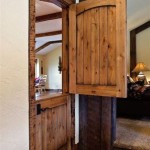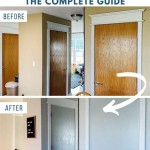How To Install Prehung Double Interior Doors With Frame
Installing prehung double interior doors with a frame can significantly enhance the aesthetic appeal and functionality of a home. This project, while manageable for a skilled DIY enthusiast, requires careful planning, precise measurements, and a methodical approach. The following guide outlines the necessary steps to successfully install prehung double interior doors, ensuring a professional-looking result.
Before commencing the installation, it is crucial to gather all the necessary tools and materials. A comprehensive preparation phase is essential for a smooth and efficient installation process. The list of required supplies includes, but is not limited to: prehung double interior doors with frame, shims, level (2-foot and 4-foot), measuring tape, pencil, safety glasses, work gloves, hammer or rubber mallet, utility knife, wood screws (various lengths), drill with drill bit set, screwdriver (or drill with screwdriver bits), construction adhesive, and a jamb saw or multi-tool (may be needed for adjustments).
Furthermore, it is essential to inspect the prehung door unit for any damage incurred during shipping or handling. Verify that all components are present and that the doors swing smoothly within the frame. Any imperfections should be addressed prior to installation to avoid complications later in the project. It is also prudent to familiarize oneself with the manufacturer's instructions, as these may contain specific recommendations or warnings relevant to the particular door model.
Key Point 1: Preparing the Opening
Preparing the door opening is arguably the most critical step in the installation process. An improperly prepared opening can lead to misalignment, difficulty in operation, and ultimately, a compromised finished product. The first step is to remove any existing door, frame, and associated hardware completely. This includes any nails, screws, or debris that may obstruct the new door frame.
Once the opening is cleared, carefully measure the rough opening (the framed-in space where the door will be installed). Measure the width at the top, middle, and bottom of the opening. Also, measure the height on both sides. These measurements should be compared to the dimensions of the prehung door unit. The rough opening should be slightly larger (typically about 1/2 inch to 1 inch) than the outside dimensions of the door frame. This allowance provides space for shimming and adjustments.
If the rough opening is too small, it will need to be enlarged. This may involve removing drywall, studs, or other framing members. If the opening is too large, it can be reduced by adding shims or furring strips to the framing. However, significantly oversized openings should be addressed by reframing the opening to ensure structural integrity and a secure fit for the door.
After verifying the size of the rough opening, check its plumb and level. Use a level to ensure that the sides of the opening are plumb (perfectly vertical) and that the top of the opening is level (perfectly horizontal). Any deviations from plumb or level must be corrected before installing the door. This can be achieved by shimming the framing members until they are properly aligned. Secure the shims with screws to prevent them from shifting during the installation process. Ensure that the shims do not protrude beyond the face of the framing, as this can interfere with the door frame.
Finally, check the opening for squareness. Measure the diagonals of the opening. If the measurements are equal, the opening is square. If they are unequal, the opening is out of square and needs to be adjusted. This can be accomplished by adjusting the framing members or shimming the jambs in a way that corrects the diagonal measurements. A square opening is essential for ensuring that the doors will operate smoothly and latch properly.
Key Point 2: Installing the Door Unit
With the rough opening properly prepared, the next step is to install the prehung door unit. This requires careful maneuvering and precise alignment. Begin by carefully lifting the door unit and positioning it within the rough opening. It may be helpful to have an assistant to help support the door unit during this process.
Once the door unit is in place, use shims to center the frame within the opening. Insert shims between the door frame and the framing of the rough opening at the top, middle, and bottom of each jamb. Start by shimming the hinge side of the door frame. This ensures that the weight of the doors is properly supported. Adjust the shims until the hinge-side jamb is perfectly plumb. Use a level to verify plumb. Secure the shims in place with wood screws, driving the screws through the jamb and into the framing behind the shims.
Next, shim the latch side of the door frame. Adjust the shims until the latch-side jamb is also perfectly plumb. Check that the gap between the doors and the jamb is consistent along the entire length of the jamb. This ensures that the doors will close properly and latch securely. Secure the shims in place with wood screws, as with the hinge side.
After both jambs are plumb and the gap between the doors and frame is consistent, shim the head jamb (the top of the frame). Ensure that the head jamb is level. Use a level to verify level. Secure the shims in place with wood screws. It is important to avoid over-shimming, as this can cause the frame to bow or twist, leading to operational problems with the doors.
Once the door unit is shimmed and secured, test the operation of the doors. Open and close both doors to ensure that they swing smoothly and latch properly. If the doors bind or rub against the frame, adjust the shims as needed to correct the problem. If the doors do not latch properly, check the alignment of the strike plates and adjust them as necessary. It may be necessary to deepen mortises for hinges to align doors correctly.
After verifying the operation of the doors, fill any remaining gaps between the door frame and the framing with insulation. This helps to improve energy efficiency and reduce drafts. Use expanding foam or fiberglass insulation for this purpose. Be careful not to overfill the gaps, as this can cause the frame to bow or distort. Trim any excess insulation flush with the surface of the wall.
Key Point 3: Finishing and Hardware Installation
The final step in the installation process is to finish the installation and install the hardware. This includes trimming excess shims, applying caulk, and installing the door handles and locksets. Cut off any excess shims that protrude beyond the surface of the wall. A utility knife or jamb saw can be used for this purpose. Be careful not to damage the drywall or plaster when cutting the shims.
Apply caulk around the perimeter of the door frame where it meets the wall. This seals the gaps and prevents drafts. Use a paintable caulk that matches the color of the trim or wall. Smooth the caulk with a wet finger or a caulk smoothing tool to create a neat and professional-looking finish.
Install the door handles and locksets according to the manufacturer's instructions. Ensure that the handles are securely fastened and that the locksets operate smoothly. Test the operation of the locksets to ensure that they latch properly and provide adequate security. Adjust the strike plates as needed to ensure proper latching. The installation may involve boring new holes or enlarging existing ones to accommodate the hardware.
Install any remaining trim or molding around the door frame. This adds a decorative touch and covers any gaps between the frame and the wall. Use finishing nails or construction adhesive to secure the trim in place. Fill any nail holes with wood filler and sand them smooth before painting or staining the trim. Apply paint or stain to the trim to match the existing woodwork in the room. Several coats may be required to achieve the desired finish. Allow the paint or stain to dry completely before touching the trim.
Inspect the finished installation carefully to ensure that all components are properly aligned and functioning correctly. Address any imperfections or adjustments that may be needed. A well-installed prehung double interior door with frame will enhance the beauty and functionality of the home for years to come. Regular maintenance, such as cleaning and lubricating the hinges, will help to keep the doors operating smoothly and prevent problems.
Consider these points to ensure a successful installation. Reviewing the instructions provided by the door manufacturer will help to eliminate any potential errors or issues during installation. Prioritizing safety during the project will protect oneself and others from harm. A well planned installation process will lead to a more efficient and effective result.

How To Install Prehung Interior Double Doors

How To Install Prehung Double French Doors Minimal Tools Required Method

How To Install Internal Double Doors Mrmachowto
Hanging Pre Hung Interior Doors Jlc

Installing A Pair Of Doors Thisiscarpentry
Hanging Pre Hung Interior Doors Jlc

How To Install A Prehung Door Tips From Novice Interior Doors Replacing Wood

Installation Of A Double Door Unit

Installing A Pair Of Doors Thisiscarpentry
Hanging Pre Hung Interior Doors Jlc
Related Posts








